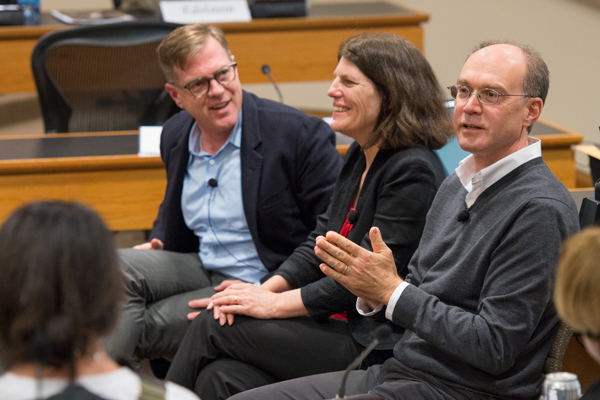
Online learning was the subject of a panel discussion at the most recent Faculty Senate meeting on Jan. 23.
President John Hennessy introduced the topic by outlining Stanford's three goals in that arena: use online technology to improve the learning experience for Stanford students; use online technology to extend the university's "reach" so that Stanford students can take courses they need as part of their requirements while studying overseas; use online technology as a tool to help others in the education community within the United States and globally.
"Higher education faces a challenge, and depending on where you are in the world, the challenge is one of affordability or accessibility," Hennessy said. "In the U.S. the challenge is rapidly becoming affordability; in many parts of the world, sub-Saharan Africa, for example, it's accessibility. We see this as an avenue where we can make a contribution to the greater good."
Mitchell L. Stevens, associate professor of education, said that with the arrival of online education, the world is on the verge of an "epochal and pivotal moment" in the history of higher education on a scale of importance as deep as the expansion of higher education after World War II with the GI Bill.
"This is a very different kind of change," said Stevens. "It feels frightening to many of us because an epoch is ending – an epoch that many of us profited from and had a great deal of ideological investment in. But like that other change, I think it's also a moment that's ripe with possibilities and reasons to be optimistic in ways that we're just beginning to imagine."
Candace Thille, assistant professor of education and senior research fellow at the Office of the Vice Provost for Online Learning, said Stanford is in a privileged position because of its resources and its amazing research capacity.
"But the really big reason we're in a privileged position is because the world is watching Stanford," Thille said. "And we have an opportunity, in this transformation that Mitchell [Stevens] was talking about, to shape it and to play a real leadership role – as opposed to letting the transformation happen. And I'm going to encourage us to take a very active leadership role."
Stevens and Thille are conveners of Education's Digital Future, a project of Stanford Graduate School of Education designed as a hub for discussion of critical questions about the digital transformation of education – through coursework, town-hall forums and expert lectures.
John Mitchell, vice provost for online learning and a professor of computer science, said Stanford would like to develop materials and use them in multiple ways.
"Faculty time is a really scarce resource, so if we can produce things that are useful on campus for our own students here, and then distribute, market and repackage them in different ways, we'll get a much greater leverage and productivity out of our effort than if we were to produce different kinds of material for different audiences."
Over the last two years, Mitchell said, more than 100 Stanford faculty from all seven schools have worked to produce 171 different courses, including on-campus experiences that used technology in an innovative way or public online classes.
"I think there are about 65 distinct new MOOCs [massive open online courses] that we have released on different platforms," Mitchell said. "I think that's much more than any other institution, so we clearly have had a big impact and an ability to reach further through that medium than other institutions."
The full minutes of the meeting, which also included a discussion about new overseas programs, are posted on the Faculty Senate website. The minutes include the question-and-answer session that followed the presentations. The next senate meeting will be held Feb. 6.
___
Kathleen J. Sullivan is a writer for the Stanford News Service. A version of this story originally appeared in Stanford Report.
Subscribe to our monthly newsletter.